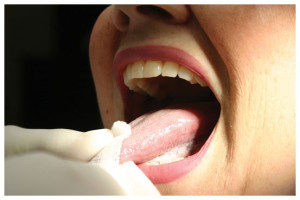There are three times as many cases of oral cancer compared to cervical cancer and three times as many oral cancer deaths every year.

Most of us know the increased risks for oral cancer to be smoking and drinking as the top risk factors, but DID YOU KNOW?
- The fastest growing patient profile are non-smokers in the 25-50 age range. Yes NON-SMOKERS. White, non-smoking males age 35 and 55 are most at risk, 4 to 1 over females.
- The CULPRIT is the Human papillomavirus or HPV which also causes cervical cancer in women. You can have HPV without ever knowing it because the virus is often cleared by our immune system without noticeable signs or symptoms. This virus can lay dormant for years without us knowing we were exposed or had it.
What You Can Do to Reduce The Risk
- Eliminate use of tobacco products and avoid excessive alcohol consumption.
- Eat a well balanced diet with fruits and vegetables.
- Avoid the combination of tobacco and alcohol.
- Protect yourself from the sun.
- Practice safe sex and limit number of sexual partners to reduce risk of getting the HPV infection.
- Consider the HPV vaccination before becoming sexually active.
- Screen yourself and see a dental professional regularly for your oral cancer screening.
- If you notice anything out of the ordinary get it checked out as soon as possible.
What to Look For?
- Red or White patch in the mouth.
- Lump or thickening of tissue in the mouth, neck or face.
- Sore in the mouth, including under a denture or appliance that bleeds easily or does not heal within 14 days
- Numbness in the mouth or face.
- Persistent earache in only one side.
- Continuous sore throat or persistent infection that lasts for a long time or keeps recurring.
- Hoarseness or change in speech.
- Pain or difficulty swallowing, speaking, chewing or moving the jaw or tongue.
- A lump in the throat or feeling something is caught in the throat.
Oral Cancer is the 9th most commonly diagnosed cancer in Canadian males and 14th for Canadian females.
Here is a great educational video on Oral Cancer Self-Exam done by our
College of Dental Hygienists of Ontario.
To download your own Oral Cancer Screening Booklet click on this link.
The information contained in this blog was from The Canadian Dental Hygienists Association Oh Canada Magazine Spring Issue 2016.